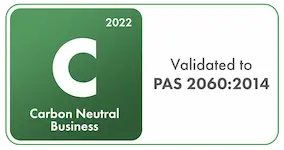A guide to scope 1, 2 & 3 emissions
As part of our efforts to reach net zero direct emissions by 2030, we’ve adopted a number of frameworks designed to help us quantify our current carbon footprint in order for us to find ways to reduce it. This means that you’ll see us referring to emissions in terms of scope 1, 2 and 3 – and in this guide, we explain exactly what this means, how it works and how your emissions can be measured in the same way.


What are scope 1, 2 & 3 emissions?
The three different scopes are headings for different emission classifications. They’re used as a tool to break down a business or organisation’s carbon output into manageable and accurate subsections based on their originating source – which can come from within or outside the organisation itself.
The scope 1, 2 and 3 terminology was introduced in the Greenhouse Gas Protocol (GHG Protocol), which provided a method of accurate GHG accounting for businesses. It was released alongside a range of calculation tools designed to assist organisations to calculate emission production, and is now the world’s most widespread greenhouse gas accounting standard.
What do the different scopes cover?
Each of the three scopes included in the Greenhouse Gas Protocol cover a distinct portion of a business’ emissions profile, which can be summarised as:
Scope 1: these are the emissions directly produced by a business or organisation in its day-to-day activity. This could be:
- Manufacturing materials or finished products
- Onsite power and heat generation (this excludes purchased energy)
- Transport emissions produced by vehicles belonging to the business
Scope 1 also includes any “fugitive emissions”, which include escaped gases – this could be refrigerants or vapours from pressurised containers.
Scope 2: this category covers all emissions indirectly produced by purchased energy, including:
- Electricity
- Heating (including gas or alternative energy sources)
Scope 3: covers all remaining indirect emissions (i.e. those not produced by the company itself, but as a consequence of its operations). It typically accounts for the vast majority of a business’ emissions but occurs within sources not owned or controlled by it. This category includes:
- Upstream supply chain emissions (extraction, refinement, production & transport of purchased materials)
- Any fuel or energy-related activities not covered by scopes 1 & 2
- Transportation and distribution (both upstream and downstream)
- Business travel and employee commutes
- Emissions produced by the use of sold products or services
- Waste and its disposal (including any sold product at the end of its lifespan)


Why do we use scope 1, 2 & 3 to calculate our emissions?
When Speedy Fuels made a commitment to reach net zero direct emissions, it became essential that we were able to accurately measure our current carbon footprint to reduce it transparently.
The Greenhouse Gas Protocol’s framework means that we’re not only able to accurately calculate our emissions but are able to measure how our initiatives are having an impact on our carbon footprint. This progress against the FY20/21 baseline is reported on every year and is made available to stakeholders.
Ready to start your journey to net zero?
Leading your business to net zero doesn’t have to begin with expensive infrastructure changes or complex audits of your operations. With Speedy Fuels, you have access to a range of more sustainable fuels that can reduce your net emissions from day 1.
Call our friendly team of experts on 0333 200 0209 to find out more.






